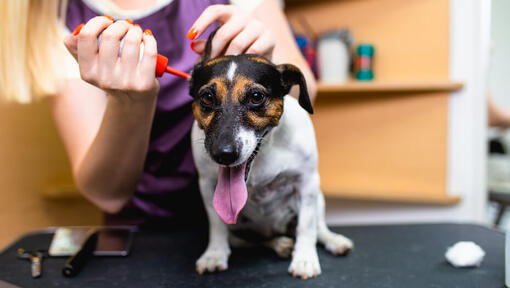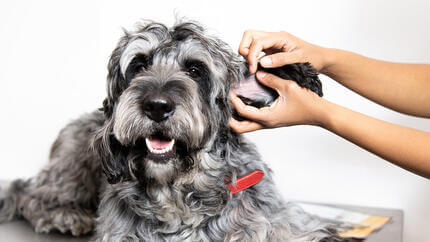
Ear infections in dogs aren’t uncommon, but with the right care and treatment you can keep your dog’s ears nice and clean, and prevent further earache for both of you!
Symptoms of dog ear problems
Your dog’s ears really benefit from a regular check-up, which is something you can share with them as part of an enjoyable grooming routine.
Look out for any changes in your dog’s ear health; you know them best. Your dog's ears should always be clean and without any thick brown or green waxy discharge. There should also be no redness, itchiness or unusual smells coming from them.
Unusual behaviour in your canine companion might also indicate a problem. If they start to scratch their ears frequently, shake their head more than normal, hold their head to one side, or rub one side of their face along the carpet or grass, it’s best to take them to your vet for a thorough ear examination.
Severe ear problems and ear infections in dogs can have a more serious effect, such as loss of balance, which can be distressing for you both. (Bear in mind that balance loss may also be due to other causes, so always visit your vet for advice in such instances – that way you’ll know if something else is wrong.)
Causes of dog ear problems
There are many reasons why ear problems in dogs might occur, and many include:
- Infections due to bacteria
- Yeast infections
- Parasites such as ear mites
- Foreign bodies such as grass seeds
- Growths or tumours
The shape of your dog’s internal ear can also add to the development of ear infections. Dogs have long ‘L’-shaped ear canals that easily trap dirt and moisture when they’re exploring the outdoors. Breeds with long, floppy ears or dogs that love to swim frequently are the most susceptible to ear problems, but it’s still common in many other breeds too. Often there’s nothing you can do to guarantee your dog won’t develop ear problems – but there are many ways to help.
Treating ear infections in dogs
Some ear infections in dogs can be treated relatively quickly and successfully, whilst others may need regular, intermittent treatment or even long-term treatment.
In some cases, if your dog has skin problems then their ears will also be affected. Your vet will be able to examine your dog’s ears safely and advise on any tests or treatment that might be needed.
Helping to prevent ear problems in dogs
To minimise the occurrence of ear infections in your dog, simply keep their ears clean and check them regularly for any signs of discharge or unusual odour.
If you have a beautiful long-eared breed, they’ll particularly benefit from regular ear cleaning with special ear cleaners and dog ear drops as recommended by your vet. Remember that as well as being one of their sharpest senses, the ear is a very delicate and sensitive area for dogs. As the eardrum can be easily perforated, our PetCare experts recommend you don’t probe your dog’s ear canal with cotton buds. If you’re unsure, ask your vet how to use cotton balls and to recommend a suitable ear cleaner that won’t cause any skin irritation or dry out your dog’s ear too much.
For thinly-haired dogs or those with white-tipped ears, protect their ears in the summer and consider using doggy sunscreen lotion to help prevent sunburn (which can lead to skin cancer).
Although there are many things that you can do to help keep your dog’s ears healthy, there are some conditions that can’t be prevented. One of them is deafness, which affects many different types of dog and can be caused by a range of factors. There’s no need to worry - dogs cope very well with hearing loss, and with changes to the way they are looked after, they shouldn’t have any less fun than before!
Discover how to clean a dog's ear safely and effectively, next.













